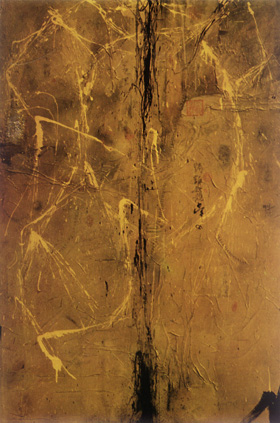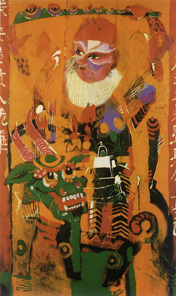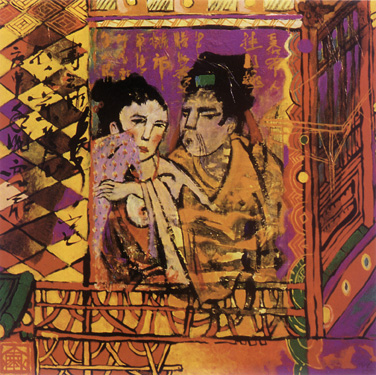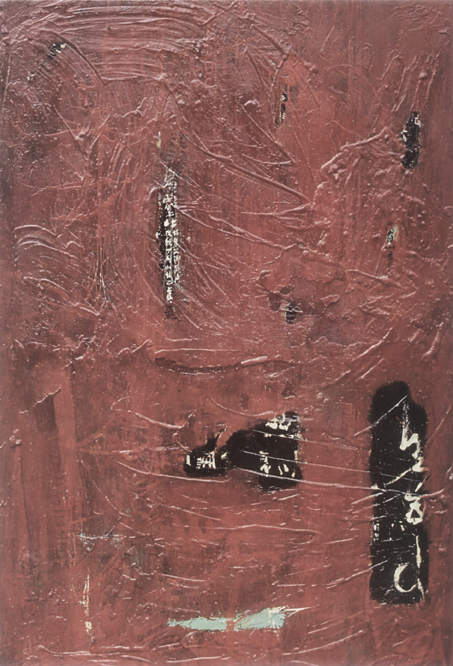Carlos Marreiros
THE IMAGE OF A PAINTER
 Huang Ho. Mixed media, 184 x 122 cm, 1989.
Huang Ho. Mixed media, 184 x 122 cm, 1989.
 Warrior. Acrylic on wood, 122 x 200 cm, 1992.
Warrior. Acrylic on wood, 122 x 200 cm, 1992.
I owe my visit to the East to Carlos Marreiros. He of course knew of my love for Chinese culture and the proof is that straight away at our first meeting, on passing through Oporto, he gave me a small ceramic Li Bai, very delicately worked, although in that conventional pose which is not to be wondered at, as this is how poets are depicted everywhere in the world: an air of enlightenment, receiving the grace of poetry as Saint Francis received the stigmata; it is a romantic notion which has come down to our days from Plato: Rilke and Mandelstamm were still able to listen to the voices dictating their poems and this conceit has served as the cover for so much mediocrity the world over.
Carlos did not find it easy to convince me to make this journey. However, on an October morning, in almost summer-like weather, I landed with a friend in Hong Kong. Here Enio, the most enchanting Brazilian I have ever met, was expecting us and welcomed us in the name of the Macau Cultural Institute and of its President. I was to feel Carlos's discreet presence almost daily despite the fact that I did not see much of him as he was so heavily involved in his concerns. However, at lunch on the island of Taipa, his presence at the main cultural events and a dinner at his house on the last night in the East was when he showed me his drawings and paintings and it was then, too, that he introduced me to the painter Mio Pang Fei, of whom I had already heard, as he had penned a poem of Li Bai (that magnificent one about two friends saying farewell, as they draw apart from each other whilst their horses whinny in grief), which had been commissioned by the Loyal Senate to be given to me at an interminable, typically Chinese dinner. Curiously enough, it was this poem which had drawn my attention to the splendour of Oriental poetry. Carlos Marreiros had many drawings of demented surrealistic inspiration, calling to mind some of the temptations of Hieronymus Bosch and the hallucinating fantasies of Mário Botas. As to his paintings, these were fewer and totally different, more to my liking in fact, reminding one of an art apprenticeship with one of the masters of our time, Antonio Tapiès; particularly the Tapiès of passion for genuine matter which lies close at hand, which you touch with your five senses, your fingers coming away feeling damp with the very substance of time; a Tapiès before he gave in to market facilities and strategies.

Dream of the Red Pavillion, I (Hong Lâu Mông).
Acrylic on wood, 120 x 120 cm, 1993.
The next time I saw paintings by Carlos was when the Nasoni Gallery exhibited the work with which he and Mio Pang Fei had represented Macau in Europalia. In these paintings you felt the stylistic desire without which Man cannot build the house "where the Gods and the stars are born", as Apollinaire more or less said in one of my favourite calligrams. None of the paintings facing me had been achieved in a vacuum. In them one could feel the artist's vital ardour seeking to give a face, a soul, or perhaps simply a name to the small, humble things he stumbled across every day or which chanced to come through his garden gate. There was something in those surfaces scarred by emotion which called out to us, demanding our attention, our affection even. It might be no more than an adolescent heart - but it begged. It was a weak voice, as if it had emerged from a poem by Camilo Pessanha and taken refuge behind those moist greens or vibrant reds: a voice which could not guide us because the ways of art are unpredictable. "The highest aim of the traveller is to be unaware of where he is going", says Chinese wisdom, which is by no means negligible. It is not only the traveller, however, who must be unaware of the way; no poet knows where the rhythm of his syllables will lead him, no painter can foresee where his colours will take him. It is true to say that "No hay camino/se hace camino al andar" (There is no road to follow / the road is made by forging ahead).
From those canvases with enigmatic titles such as San Sui, The Empress's Earrings, Nocturnal Triangle, from those canvases, as I was saying, harsh as childhood places, brief and unexpected beams of. light broke out, the triumphant blackness of Chinese characters, small childish scrawling or suchlike things, bird droppings, decaying leaves, all conspiring with the Autumn wind and the wet earth whose smell, without one really knowing where it came from, permeated the room, or was it that "special spiritual perfume" which Kandinsky sensed in certain finished forms? Who knows?

Xian. Mixed media, 200 x 122 cm, 1991.
* Poet and author, famous worldwide, with thirty-six works published in nearly twenty languages. He is considered as one of Portugal's foremost contemporary poets.
start p. 137
end p.